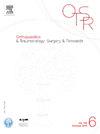在法国的全膝关节置换术样本中,能否确定牛津评分、KOOS 及其衍生物的最小临床重要性差异 (MCID)?
IF 2.3
3区 医学
Q2 ORTHOPEDICS
引用次数: 0
摘要
背景:要评估外科手术对患者的影响,传统的做法是使用手术前后的临床评分,但越来越多的人建议使用最小临床重要差异("MCID")的概念来权衡这些评分结果。在确定 MCID 时,既可以使用基于评分变化的数据分布法,也可以使用锚定法,即使用外部问题对结果进行分类。MCID因人而异,据我们所知,法国尚未对全膝关节置换术(TKA)进行过调查。因此,我们针对全膝关节置换术人群开展了一项前瞻性研究,目的是1)确定牛津评分、KOOS(膝关节损伤和骨关节炎结果评分)及其衍生物在法国全膝关节置换术人群中的 MCID,2)确定这些评分在法国的 MCID 是否与文献结果相当:假设:法国全膝关节置换术的 MCID 是否与其他文献中的结果具有可比性?这是一项前瞻性观察研究,在最初纳入的 300 名接受初级 TKA 的患者中,有 218 名患者(85 名男性,133 名女性)(平均年龄为 72 岁 [27-90])在手术前后回答了牛津-12、KOOS 和遗忘关节评分 (FJS) 问题(平均随访 24 个月)。采用分布法和锚定法("改善1至5 "和 "改善是或否")计算MCID:结果:在平均 24 个月[18-36]的随访中,牛津-12 评分从 16 ± 8 [0-41] 增加到 34 ± 11 [6-48](p 讨论):在法国人群中,牛津-12、KOOS及其衍生评分的MCID与文献中观察到的其他人群的MCID相当:证据等级:IV;无对照组的前瞻性研究。本文章由计算机程序翻译,如有差异,请以英文原文为准。
Can the minimal clinically important difference (MCID) for the Oxford score, KOOS and its derivatives be identified in a French sample of total knee arthroplasties?
Context
To assess the effect of a surgical procedure on a patient, it is conventional to use clinical scores before and after the procedure, but it is increasingly common and recommended to weight the results of these scores with the notion of minimal clinically important difference (“MCID”).
This MCID should be determined using either the data distribution method based on score variation, or the anchor method, which uses an external question to categorize the results. MCIDs vary from one population to another, and to our knowledge there has been no investigation in France for total knee arthroplasties (TKAs). We therefore conducted a prospective study on a population of TKAs in order to: 1) Define MCID in France on a population of TKAs for the Oxford score, KOOS (Knee injury and Osteoarthritis Outcome Score) and its derivatives, 2) Determine whether MCID for these scores in France is comparable to results in the literature.
Hypothesis
Is the MCID for total knee arthroplasty in France comparable to other results in the literature?
Material and method
This was a prospective observational study in which 218 patients (85 men, 133 women) with a mean age of 72 years [27–90] who had undergone a primary TKA out of 300 initially included responded, before and after surgery, to the Oxford-12, KOOS and Forgotten Joint Score (FJS) questions (mean follow-up 24 months). MCID was calculated using the distribution method as well as the anchor method (“improvement 1 to 5” and “improvement yes or no”).
Results
At a mean follow-up of 24 months [18–36], the Oxford-12 score increased from 16 ± 8 [0–41] to 34 ± 11 [6–48] (p < 0.001), all components of the KOOS score were improved and the FJS at follow-up was 47 ± 32 [0–100]. For the anchor “improvement 1 to 5”, there were 14 unimproved patients, 23 patients in identical condition and 179 patients improved by surgery.
For the anchor “are you improved yes/no”, there were 8 unimproved patients, 22 in identical condition and 187 surgically-improved patients. The mean MCID for all methods (anchor method and distribution) was 10 [7–13] for Oxford-12, 12 [12–12] for KOOS Symptom, 14 [12–17] for KOOS Pain, 12 [11–14] for KOOS Function, 14 [12–16] for KOOS Sport, 15 [15–16] for KOOS Quality of Life (QOL), 11 [10–12] for KOOS 12, 15 [12–18] for KOOS 12 Pa in. 12 [12–13] for KOOS 12 Function, 15 [15–15] for KOOS 12 QOL, 14 [13–14] for KOOS Physical Function Short-form (PS) and 14 [13–16] for KOOS Joint Replacement (JR).
Discussion
The MCID for the Oxford-12, KOOS and its derivatives scores in a French population is comparable to that observed in other populations in the literature.
Level of evidence
IV; prospective study without control group.
求助全文
通过发布文献求助,成功后即可免费获取论文全文。
去求助
来源期刊
CiteScore
5.10
自引率
26.10%
发文量
329
审稿时长
12.5 weeks
期刊介绍:
Orthopaedics & Traumatology: Surgery & Research (OTSR) publishes original scientific work in English related to all domains of orthopaedics. Original articles, Reviews, Technical notes and Concise follow-up of a former OTSR study are published in English in electronic form only and indexed in the main international databases.

 求助内容:
求助内容: 应助结果提醒方式:
应助结果提醒方式:


